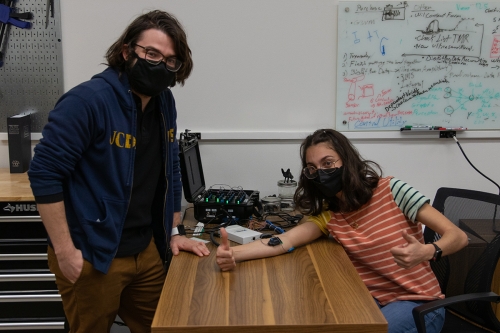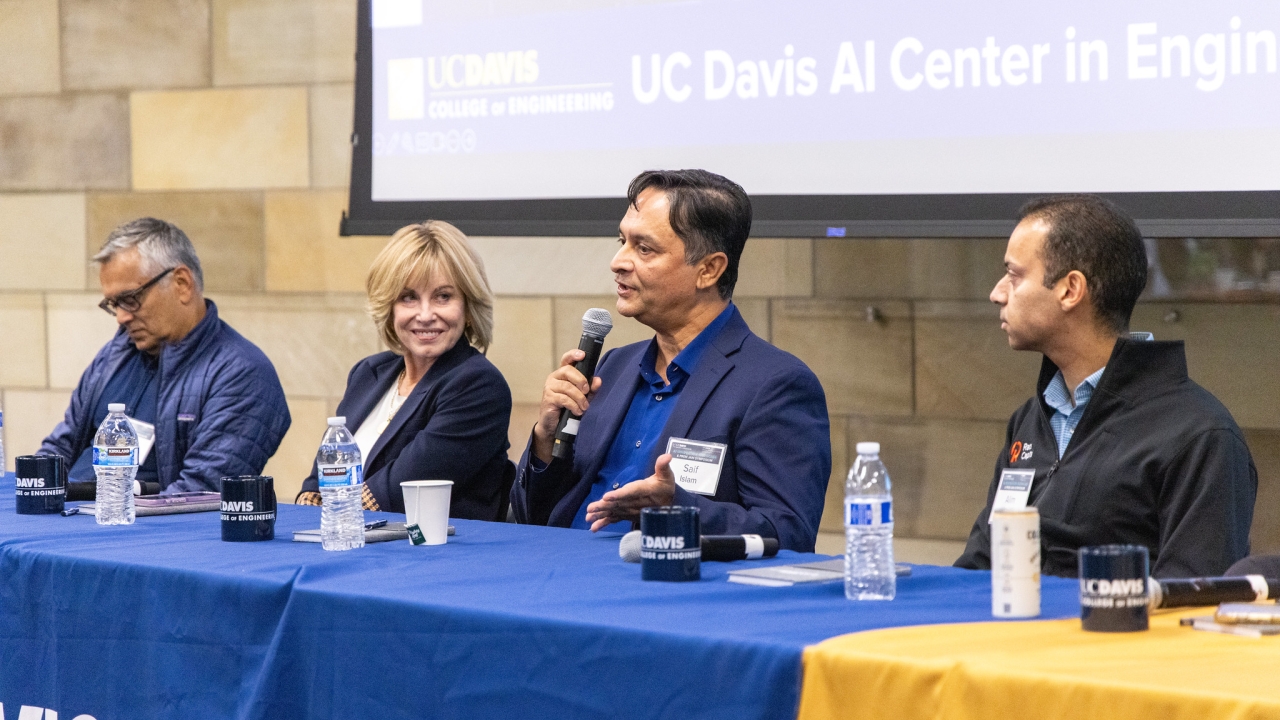Anna Rita Moukarzel Combines Love of Dance, Robotics with Neuroengineering Research

Second-year mechanical and aerospace engineering master's student Anna Rita Moukarzel’s love for the world of neuroengineering is rooted in her background in robotics and the performing arts.
Moukarzel graduated from UC Davis in 2020 with a B.S. in mechanical engineering with a minor in theater & dance, and she is currently a graduate student in Mechanical and Aerospace Engineering Assistant Professor Jonathon Schofield’s Bionic Engineering and Assistive Robotics (BEAR) Lab completing her thesis on accessible and assistive biomedical devices for amputees using robotics.
“As a dancer, I know a lot about fluidity and what the body can do, so it’s really cool to apply my dance background to neuroengineering when thinking about how the robot should move,” she said.
This helps Moukarzel and the BEAR Lab use sonomyography, or SMG, an emerging prosthetic control technique, for patients who have undergone targeted muscle reinnervation, or N-TMR. N-TMR is a surgical procedure performed at the time of amputation that aims to reduce and prevent phantom limb pain and neuromas, large painful masses of nerve endings that form when injured nerves are unable to properly regenerate.
During N-TMR, the nerves that have been severed are rerouted into the motor nerves deep inside the adjacent target muscles that become functionless after amputation. After reinnervation, a patient thinks about moving their arm and neural signals trigger muscle contractions in the residual limb. The resulting myoelectrical signals from the contraction are then detected and used to move the bionic device.
Though effective, reinnervating nerves deep into muscle tissue ultimately leads to noisy signals that conventional prosthetic control systems like surface electromyography have difficulty reading and distinguishing for bionic control.
Translating Muscle Signals
Moukarzel’s team works primarily with N-TMR patients who have transhumeral and transradial amputations, located above the elbow and lower arm, respectively.

The team predicts that integrating SMG with machine learning will produce more accurately-classified muscle contractions from intended hand motion. To accomplish this, they ask participants to move their missing limb and use binary images generated from the muscle contractions to drive a prosthetic device. The SMG uses the binary images like QR codes to capture muscle deformation and classify movement with machine learning algorithms.
“When we do sonomyography on our computer, similar to an ultrasound, you can see the muscle move and the participants love watching their muscles change onscreen,” Moukarzel said. “It’s really cool because sometimes it’s so differentiable that even the human eye can easily see it.”
Currently, the team is observing 82-100 percent accuracy across all hand movements. These preliminary results could provide more opportunities to establish advanced bionic control for N-TMR patients.
The latest stage of Moukarzel’s thesis involves integrating vibrations into prostheses for feedback. She created a research device called the HummingBear that aims to restore the sensation of movement for missing limbs at the N-TMR location by vibrating at a certain frequency. For example, a patient would imagine their hand closing into a fist, then feel the vibrational sensation of forming a fist using the prosthetic device
The HummingBear would be significantly more affordable for research labs to use and serve as added sensory feedback for devices. This, in turn, will advance bionic prostheses and improve embodiment, the sensation of feeling like the device is part of the body. In the future, the lab hopes this feedback will make advanced bionic control more accessible to many amputees compared to current control systems that require invasive surgeries.
Taking the Next Step
During her undergraduate years at UC Davis, Moukarzel focused heavily on advocating for women in STEM. As head coach for the C-STEM GIRL/GIRL+, or Girls in Robotics Leadership, Camp, she designed a summer curriculum for middle and high school students who are interested in developing their passions in robotics, circuitry, and coding. She was also the Plant Bioprinter Mechanical Lead for the BioInnovation Group at UC Davis, where she developed a 3D printer for hydrogel.
Her dance and theater training as an undergraduate also nurtured her presentation and projection skills for graduate school. Moukarzel won Best Oral Presentation Award for her presentation, “Establishing Target Muscle Reinnervation for the Prevention of Neuromas and Phantom Pain for Bionic Prosthesis Control,” at the UC Davis Center for Neuroengineering and Medicine Inaugural Research Symposium in June 2022. She also presented her current project at the Society for Neuroscience Conference in San Diego.
Through it all, she’s been grateful to be working with her team at the BEAR Lab.
"We have a very healthy lab, everyone has a great relationship, and we have a lot of fun,” she said. “Professor Schofield is a great PI who really focuses on the improvement and growth of you as an individual and we’re very fortunate to have him.”
After completing her master’s, she aims to pursue a Ph.D. and continue her work with non-invasive neutrally-controlled devices in academia or industry. Her advice for undergraduates who are interested in pursuing graduate school is to not be afraid to ask professors to do research with them.
“If you’re interested in a specific research area, UC Davis has so many types of labs, so talk to a professor about their work,” she said. “We have undergraduates in our labs who we consider part of our family, and they love to ask us about grad school and how to prepare. Start early but if you don’t immediately know what you want to do yet it's okay.”




